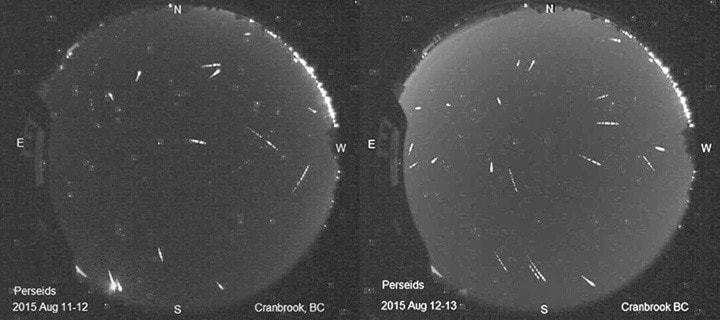Barry Coulter
Turn your gaze upwards, readers, Thursday night and Friday night. The night sky will be ablaze with meteors.
It is the time of year for the annual Perseid Meteor shower. And experts are predicting that, at its peak on August 11-12, there will be twice as many meteors that usual. Considering that the Perseids are one of the most spectacular astronomical events of the year, expect Thursday night especially to be quite a light show.
Rick Nowell, Astronomy Lab Technician with College of the Rockies in Cranbrook, reports that the college meteor camera is already seeing more bright meteors zipping overhead.
The Perseids are a prolific meteor shower associated with the comet Swift–Tuttle. They are so called because the point from which they appear to come, called the radiant, lies in the constellation Perseus.
"The Perseid meteor shower started July 17 and ends August 24, but peaks on Thursday night, August 11, and Friday morning, August 12," Nowell wrote. "If it's cloudy Thursday, note that Wednesday night and Friday night will also be very active.
Nowell said that this year the Earth will cross the centre of the comet debris; "so we should get the full show. We should also get three additional early peaks: Jupiter's gravity has shifted some debris; and we'll see debris from the 1862 and 1479 comet ejection trails to hit this year."
Peak estimates (by Esko Lyytinen and Mikhail Maslov) are 150 to 160 meteors per hour, about three per minute.
Nowell said there are four peaks in two waves — "we'll miss the first wave since it hits Thursday in daylight; and the last wave which hits in Friday's morning light. But the whole night should be pretty constant at 100 meteors/hour.:
Best seeing times in the East Kootenay would be after midnight once the Moon sets (low in Scorpius) and the skies darken; continuing until dawn at 5 am.
"We'll miss the last wave at 7 am. But these peak times are estimates, we can hope they arrive during darkness instead."
• Thursday Aug 11 at 4:34pm (Mountain Daylight Savings Time) [1862 comet trail]
• Aug 11 at 5:24pm [1479 comet trail]
• Aug 11 from 6 to 10pm [Jupiter shifts]
• Friday morning; Aug 12 from 7 to 9am [Centre of main comet orbit].
Nowell said it takes the Earth a week to pass through all the ice and dust from comet Swift-Tuttle. The shower will gradually taper off and end by Aug. 24. The meteors are travelling at a speed of 59 km/s when they enter the Earth's atmosphere. Their trails will all point to Perseus (if it's a Perseid). The closer they are to Perseus, the smaller their trail: and the further away, the longer the trail. Look for their colours—at high speed they ionize the air to a green; then that fades to yellow, orange, red as it slows down. If they disrupt and flare, you may see green/bluish wide streaks that glow afterward for a second or two (mainly it's water ice, but there may be metals present like copper or cobalt).
Below: This photo shows a k-Cygnid meteor crossing through Cygnus the Swan as seen during the last Perseid shower of 2015 (it’s tail is short and it points from Cygnus). Photo taken with a Nikon D100, Tamron 28mm f/2.5 lens, 30 second exposure. I outlined Cygnus in yellow against the Milky Way. The bright star Deneb is the tail at top, and Albireo is the beak at bottom.

Below: While you’re out stargazing, here is a starmap showing the Perseus region of the sky, looking Northeast late after midnight in August. The Milky Way band (grey in the map) runs through Perseus; who is the Greek hero coming to rescue Andromeda (daughter of Cassiopeia) who is chained to the rocks. Look below the W of Cassiopeia (the Queen of Ethiopia). You should also see the great square of Pegasus, the winged horse to the right. If you have good eyes (or binoculars), you can spot the fuzzy cloud of the Andromeda Galaxy (M31 in the Map) just above Andromeda’s stick-figure knee. (Andromeda’s head is one corner of the square of Pegasus.) The big dipper, little dipper and Polaris are easy to locate to the left. (Starmap generated by Skyglobe software).

